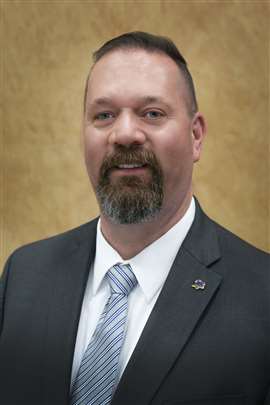Construction’s labour problems aren’t a mystery...so what are the solutions?
20 November 2024
The construction industry in recent years has been clear about its shortcomings, and few issues have been so sustaining as the thin labour market.
 Skanska workers wearing the new vests. Photo: Skanska
Skanska workers wearing the new vests. Photo: Skanska
Looking at US Bureau of Labor Statistics data shows the amount of workers 55 years old or older in the construction workforce has more than doubled since 2003. At present, just over 22% of the industry is in this age bracket (or one-in-five workers).
That’s worrying when, as Greg Sizemore, vice president of workforce development, safety, health and environmental at US-based Associated Builders and Contractors (ABC), points out to Construction Briefing, the average retirement age in the country is 61.
“Our workforce is aging,” Sizemore said. His trade association represents more than 23,000 commercial contractors and construction firms in America, which offers him a birds-eye-view of the dilemma.
The industry suffers from a “Trident effect”, according to Sizemore – a nautically themed way of saying three key issues plague construction.
“One, we’ve got an aging population,” he says, adding that the second prong involves youth recruitment and retention. “We’re got a younger generation that, to be honest with you, do not know the opportunities that are available to them in construction.”
Sizemore says that the US shift over the decades in preparing high school students for college instead of careers has also stifled labour.
The third prong, Sizemore said, is that – even for the construction-initiated – learning-programmes and higher education are under-supported in the sector, in his view. “Matter of fact, the dropout rate can be as high as 50% [for] those that actually go through and get a degree,” added Sizemore.
Showing youth myriad possibilities in construction
 Associated Builders and Contractors (ABC) Vice President of Health and Safety Greg Sizemore outside the White House in Washington D.C., US. (Image: ABC)
Associated Builders and Contractors (ABC) Vice President of Health and Safety Greg Sizemore outside the White House in Washington D.C., US. (Image: ABC)
So, what can be done?
Sizemore says industry-organised initiatives to reach the youngest generations are immensely helpful. Whether a lack of exposure or information, Sizemore says it is clear construction is not reaching America’s young people early enough to illustrate the tapestry of opportunity in building and infrastructure.
Part of the issue, too, could be that school-aged children aren’t hearing enough from the youngest personnel already working in construction.
At a recent roundtable, 2024 summer interns for Skanska USA discussed ways to engage more future labourers, while expressing the early positives of their budding career in construction. Much like Sizemore suggests, the four interns (of which two are back at school and two others joined Skanska full-time) encouraged firms and trade organisations to recommit to developing relationships with high schools and even middle and elementary schools.
Amelia Johnston, a student at Purdue University in Indiana, did the Skanska Building Summer 2024 Project Engineer internship this year, and she notes how early opportunities can be formative.
“I think one way to make it a positive opinion would be to expose high schoolers or even middle schoolers to the construction industry earlier and expose them to the variety of different jobs,” says Johnston.
‘It’s not all hammering in the cold’
Johnston, who accepted a permanent role with Skanska set to start in May 2025 after she graduates, says that like any major industry, there are hosts of administrative, management, and technological opportunities that young people often don’t see.
George Ojo, also a project engineer intern and current assistant project engineer for Skanska USA Building, notes that targeted communications in schools is a great idea for construction, but that creating access to more opportunities for university students, recent grads, and young professionals seeking a career change would be advantageous, as well.
Nareen Berejiklian, current project engineer for Skanska USA Building and project manager intern this summer, mirrors those thoughts. “As George and Amelia said, I believe that a certain image is put into our head when we’re younger about construction, as if it’s only hard labour.
“But, if people became more aware of how many opportunities there were in construction; you could go into CAD [computer-aided design], or if you like project management you can be a manager,” Berejiklian said. “We’re not taught that at a young age, so our view on construction is… you’re out all day in the warmth or in the super-cold doing work and hammering.”
Safety, diversity a key hurdle to retaining young construction workers
The Skanska intern roundtable also noted the industry needs to do more than just celebrate its career offerings: there are fundamental aspects that still need to change.
A popular discussion point on the roundtable was safety, with each participant recognising that while the industry has improved leaps-and-bounds over the last two decades, it still has more to do. The bright side, in the interns’ perspectives, was that they can have a hand in shaping that policy and direction.
“We have a lot of things in place on the construction site to make it safe,” says Berejiklian, who has a large role in setting safety standards and expectations for her Massachusetts-based team. “Before any subcontractor gets on site, they have to have an orientation about safety with our safety manager. We have safety [professionals] come on site.
“If we can incorporate that in curriculum at a young age, I definitely think more people would be interested in joining the construction world.”
Sarah Talavera, a summer intern for Skanska USA Civil West Coast and student at California State Polytechnic University Pomona, says an emphasis on recruiting more women to the field would also facilitate interest. Women in the US make up 50.5% of the population, but they represent about 11% of the US construction industry (4% in skilled trades and 7.7% in management).
“Not a lot of women know that this is a field that they can come into. And speaking for my project personally, I think we have [more] women [compared to other projects] in Skanska Civil. So, coming into it, that was really cool to see all of these women work together, and work with the men, as well,” says Talavera.
Construction’s labour problems aren’t a mystery, the solutions are
 John Mielke
John Mielke
The roundtable suggested construction firms of all sizes make investments in technology and modernisation, to better recruit and retain new workers. It was perhaps the one universal constructive criticism the quartet had for the field.
The four noted that falling behind on modern tech tools can be an immense turnoff for young labourers, particularly ones who are entering the field alongside the development of today’s emerging solutions.
And none of this is a mystery to the industry, but finding the most useful answers is a work in progress.
ABC’s Josh Mielke is the organisation’s national senior director of apprenticeship, and he says regional ABC chapters and members have increased time and monetary investment to bridge labour gaps.
“ABC members spent about US$1.6 billion last year on training and education,” Mielke tells Construction Briefing, noting that results and approaches vary state to state based on need or success rates.
With 67 national chapters across all 50 US states, strategies end up more as a patchwork than a nationalised gameplan, but Mielke said this can breed innovation and develop fresh initiatives that can be rolled into multiple regions.
“Everybody’s doing something a little bit different,” he acknowledges. “[It’s about] collecting best practices and trying to share those… across the country; figure out who’s got a ‘secret sauce’ and see where we can spread it.”
Staying optimistic, Mielke notes some trends show recent attention on engaging youth in construction may be paying dividends.
“We see the average age of an apprentice right now is about 26, but it used to be about 28,” he said, sensing that both parents and students are starting to see the benefits of a career in trades, particularly at a time when the general labour market is oversaturated with college-degree holders.
Mielke points out, where US university students might pay upwards of $200,000 for four years of education, construction apprentices often get paid to learn and can make around $200,000 in the same timeframe (a $400,000 swing).
“I think people are starting to understand the opportunity and some of the practical aspects of apprenticeship,” added Mielke.
What’s next for construction’s US labour market?
 Scott Cannon (Image: Skanska)
Scott Cannon (Image: Skanska)
By and large, the best advice for construction firms and contractors feeling the squeeze of a tight labour market is to find positive examples of recruiting and retaining and implement them internally or partner with an organisation that can help.
In addition to apprenticeships, internship programmes can be rich resources to fill empty positions, and they have the added benefit of being a ‘trial’ for both employee and employer.
Scott Cannon, executive vice president and general manager for Skanska Building operations in Atlanta, Georgia, came up through the Skanska internship programme in the 1990s, and notes the growth it offered him.
“Students learn a lot in their classroom curriculum, but nothing really compares to the in-depth, hands-on experience of a construction site,” says Cannon.
Connecting intern groups globally, Cannon said, has helped foster more retention, too.
“We hold a virtual Fika (a Swedish coffee and cake break) call with our Swedish interns and a networking and project highlight call with our US and United Kingdom interns,” he explains. “Our goal is to give our interns a feel for what it’s like to work at Skanska and knowing you can reach out to your colleagues across the country or across the world is part of that experience.”
But there’s also some attitudes in the industry that ABC’s Mielke points out end up perpetuating issues. Two things he said companies should absolutely not do: complain and wait around for the government to ‘fix it’.
“It’s important that we as an industry partner with education and government, but we can’t wait for either one to be the solution,” says Mielke. “It really has to be an industry-led effort, and I think it is.”
Sizemore echoes that feeling.
“Can the government help us?” he asked rhetorically. “Possibly.
“But I think this is going to come down to… simply ground-pounding in your own zip code. We need to re-educate our parents and our teachers about the endless opportunities and careers in construction. We can’t look to the government to fix our industry.”
Speaking to construction owners, managers and workers, Sizemore summed it simply by saying, “The best spokesperson for the construction industry is you.”
STAY CONNECTED



Receive the information you need when you need it through our world-leading magazines, newsletters and daily briefings.
CONNECT WITH THE TEAM









